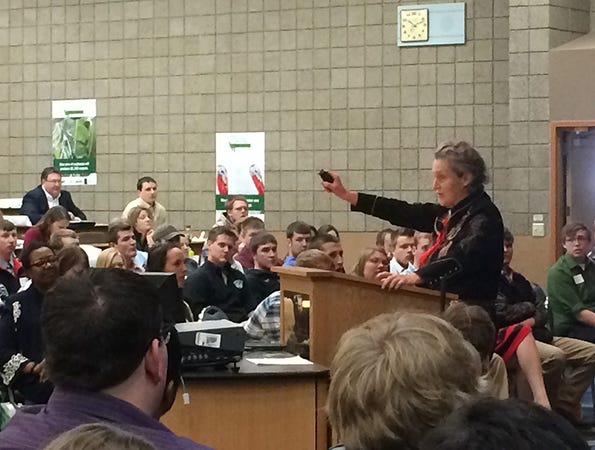February 10, 2016

“Keep Calm and Carry On” was a motivational poster created by the British government in 1939 as World War II loomed, as a way to raise the morale of the British public. That war-time motivational slogan has been commercialized beyond belief, and it seems as though everyone had adapted a “Keep Calm and …” slogan to support their product or cause.
In that mode, I think the livestock industry could adopt such a “Keep Calm” mission statement for proper animal handling.
Consumer demand, hidden videos and research have all lead to herdsmen improving their handling skills. Temple Grandin has made a career, and has become known worldwide for, designing livestock handling facilities and consulting the livestock industry on proper animal handling.
The Colorado State University animal science professor stresses calmness, both for livestock and their handlers, when working with livestock – whether it’s daily walk-throughs, processing or loading for market.
“Calm animals are easier to handle,” she told a large group at a recent Ag Symposium at South Central College in North Mankato, Minn. Once an animal is wound up and stressed, it will take 20 minutes to calm that animal down to get to the point of being able to work with them again.
A part of calmly working with your herd, regardless of species, is that Grandin suggests moving them in small groups. She recommends a 3-foot wide alley for moving pigs, and only move five pigs at a time. “If you do have 2-foot wide alleys, then move them three hogs at a time.”
Moving small groups flies in the face of getting done quickly, and Grandin says that “good handling requires more walking.” That walking may be time well spent, as she shares a story about when she was helping load semis. One semi was being loaded the “normal” way of trying to load large groups. Grandin was helping load another semi where she practiced what she teaches – moving small groups – and her semi got loaded first. So in that sense, small groups mean more walking, and more walking means less time.
To truly know what someone else is going through, it is said that you need to take a walk in their shoes. With a Grandin spin on that adage, she suggests producers and slaughterhouse workers get down to the hog’s level to see what they see as they are going through sorting and loading chutes.
“You may have to get down on all fours to see what a pig sees,” looking for obstacles or movement deterrents in their sight lines in the pen and outside the pen. “Get more observant. Watch what animals are telling you.”
Lighting is important when you are trying to move livestock, but too much at the wrong time can bring animal movement to a halt. Grandin says animals won’t move into the sun, “so you may need to change the time of day that you load hogs.” Though livestock won’t move into the sunlight, you can use light to attract animals, lighting the room or trailer where you want the hogs to move to. “Use behavior rather than force to move livestock,” she says.
Movement aids such as flags or paddles are often necessary to move livestock, but Grandin stresses an electric prod is NEVER to be used as a primary driving aid. This will only agitate the pig and make it that much more difficult to move.
Grandin says the movement of animals requires more skill, and possibly a change in genetics. She claims that some of the genetic lines found in today’s livestock make for a more agitated animal, so producers really need to take a serious look at sustainability rather than maximum performance. The trade-off may be worth it for the health of both the animal and the handler. “Calm animals are less likely to harm people,” she says.
Regular interaction with your livestock can go a long way to proper handling of your hogs, and make sure that interaction begins early. “Make sure that their first experience is good,” she says, adding that this means their first experience of everything – going into a chute, have shots, being moved from pen-to-pen, etc. “They remember that first experience.”
Some people work well with livestock, while others, well, maybe they should be relegated to other tasks on the farm, or let go all together. In this world of social media and everyone with a video camera on their phones, you don’t want your farm to show up on an incriminating hidden video. “Look at everything we do,” she says. “If it looks bad on YouTube, don’t do it. … We need to prevent bad from becoming normal.”
Proper livestock handling goes a long way in getting a healthy animal to market, so remember the next time you enter your barn “Keep Calm and Move Your Hogs.”
You May Also Like


